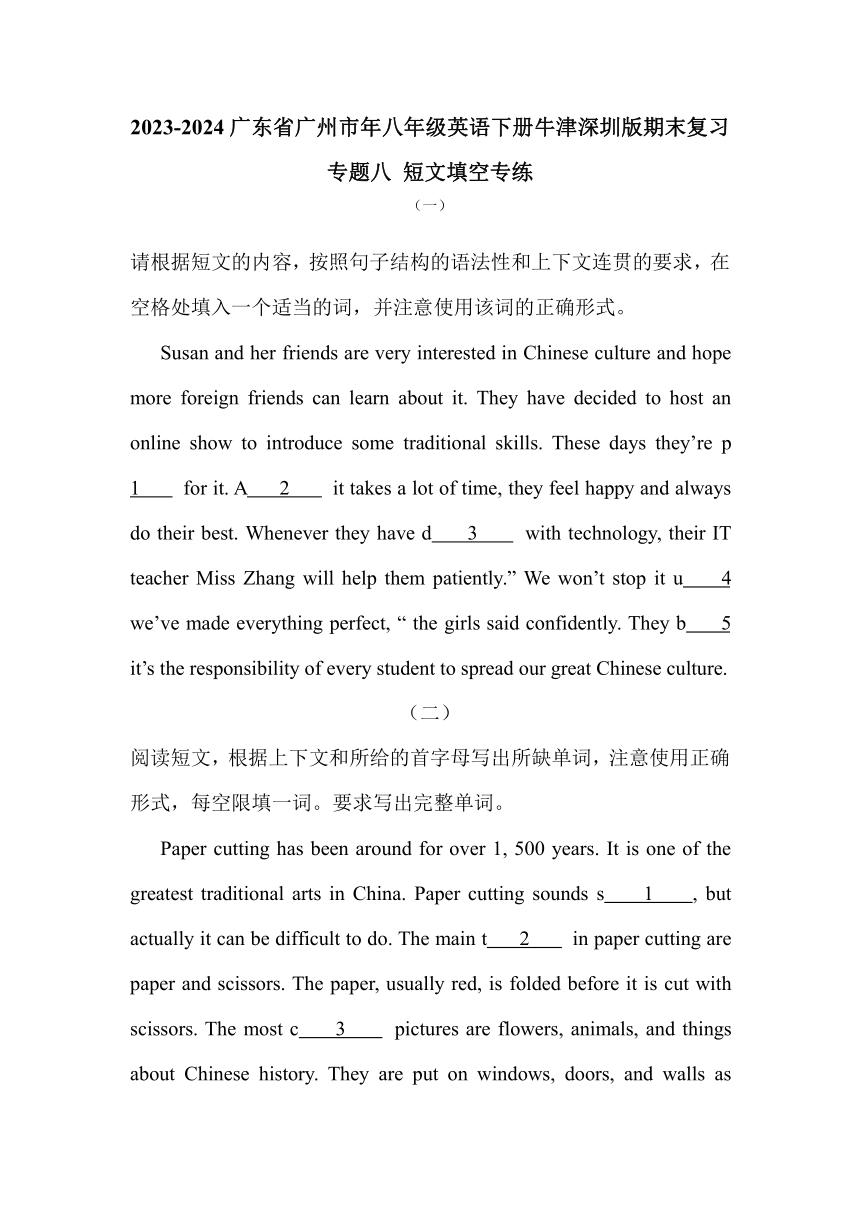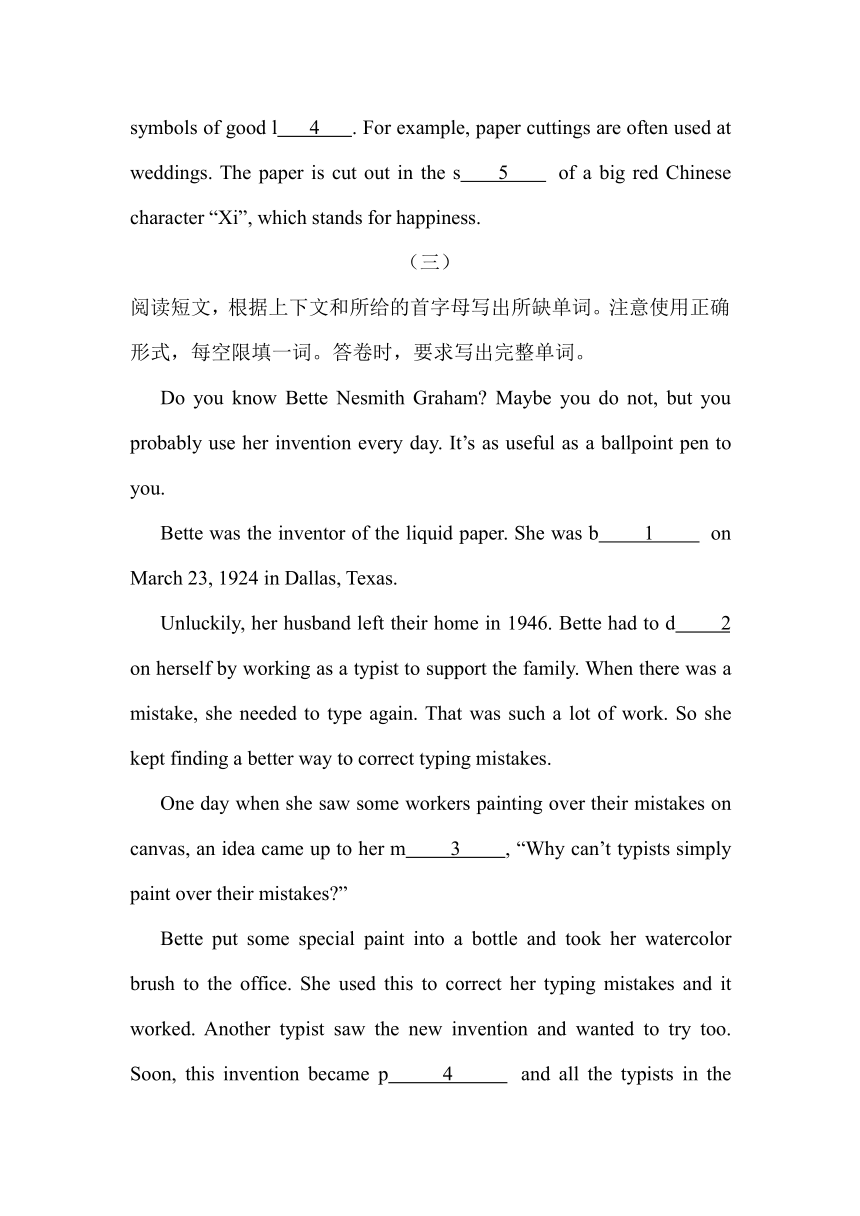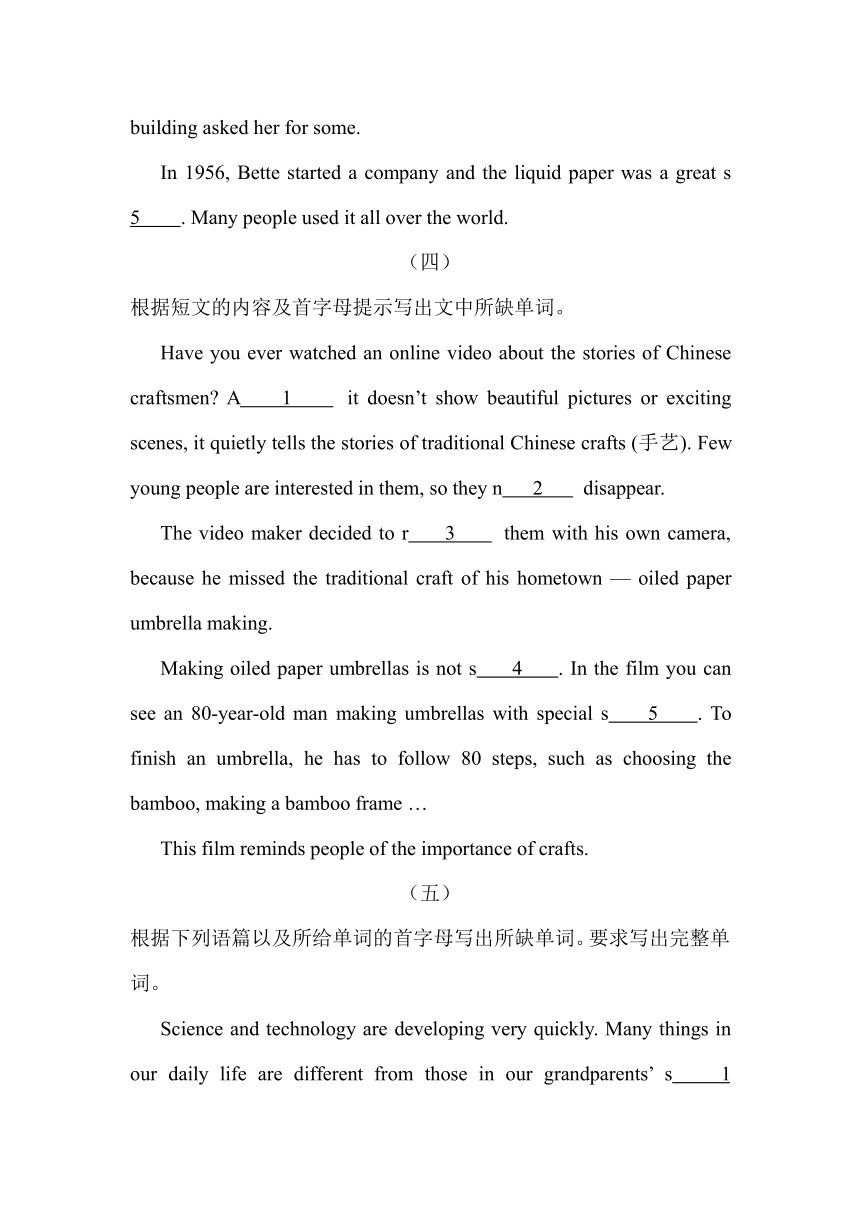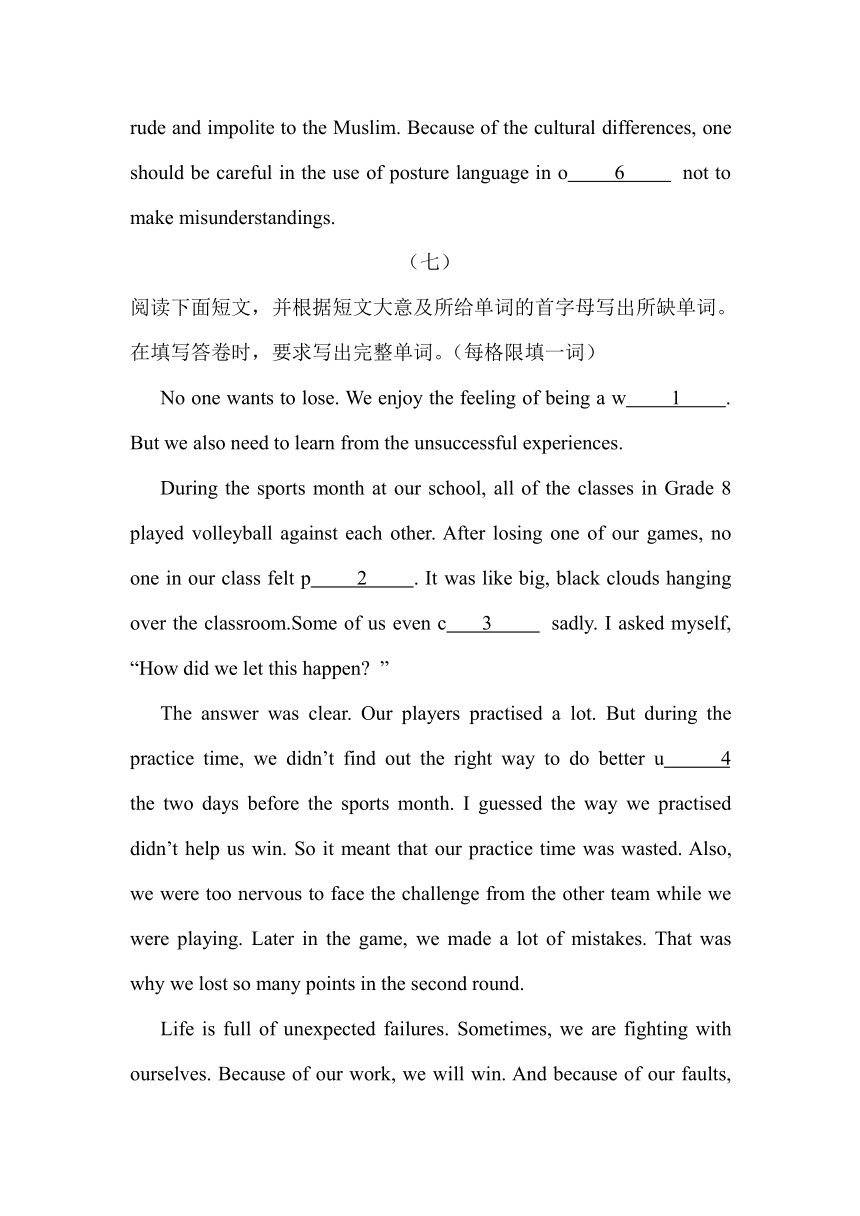期末复习专题八 短文填空专练(含解析)2023-2024学年牛津深圳版英语八年级下册
文档属性
| 名称 | 期末复习专题八 短文填空专练(含解析)2023-2024学年牛津深圳版英语八年级下册 |  | |
| 格式 | docx | ||
| 文件大小 | 27.8KB | ||
| 资源类型 | 教案 | ||
| 版本资源 | 牛津深圳版 | ||
| 科目 | 英语 | ||
| 更新时间 | 2024-05-29 15:18:26 | ||
图片预览





文档简介
2023-2024广东省广州市年八年级英语下册牛津深圳版期末复习
专题八 短文填空专练
(一)
请根据短文的内容,按照句子结构的语法性和上下文连贯的要求,在空格处填入一个适当的词,并注意使用该词的正确形式。
Susan and her friends are very interested in Chinese culture and hope more foreign friends can learn about it. They have decided to host an online show to introduce some traditional skills. These days they’re p 1 for it. A 2 it takes a lot of time, they feel happy and always do their best. Whenever they have d 3 with technology, their IT teacher Miss Zhang will help them patiently.” We won’t stop it u 4 we’ve made everything perfect, “ the girls said confidently. They b 5 it’s the responsibility of every student to spread our great Chinese culture.
(二)
阅读短文,根据上下文和所给的首字母写出所缺单词,注意使用正确形式,每空限填一词。要求写出完整单词。
Paper cutting has been around for over 1, 500 years. It is one of the greatest traditional arts in China. Paper cutting sounds s 1 , but actually it can be difficult to do. The main t 2 in paper cutting are paper and scissors. The paper, usually red, is folded before it is cut with scissors. The most c 3 pictures are flowers, animals, and things about Chinese history. They are put on windows, doors, and walls as symbols of good l 4 . For example, paper cuttings are often used at weddings. The paper is cut out in the s 5 of a big red Chinese character “Xi”, which stands for happiness.
(三)
阅读短文,根据上下文和所给的首字母写出所缺单词。注意使用正确形式,每空限填一词。答卷时,要求写出完整单词。
Do you know Bette Nesmith Graham Maybe you do not, but you probably use her invention every day. It’s as useful as a ballpoint pen to you.
Bette was the inventor of the liquid paper. She was b 1 on March 23, 1924 in Dallas, Texas.
Unluckily, her husband left their home in 1946. Bette had to d 2 on herself by working as a typist to support the family. When there was a mistake, she needed to type again. That was such a lot of work. So she kept finding a better way to correct typing mistakes.
One day when she saw some workers painting over their mistakes on canvas, an idea came up to her m 3 , “Why can’t typists simply paint over their mistakes ”
Bette put some special paint into a bottle and took her watercolor brush to the office. She used this to correct her typing mistakes and it worked. Another typist saw the new invention and wanted to try too. Soon, this invention became p 4 and all the typists in the building asked her for some.
In 1956, Bette started a company and the liquid paper was a great s 5 . Many people used it all over the world.
(四)
根据短文的内容及首字母提示写出文中所缺单词。
Have you ever watched an online video about the stories of Chinese craftsmen A 1 it doesn’t show beautiful pictures or exciting scenes, it quietly tells the stories of traditional Chinese crafts (手艺). Few young people are interested in them, so they n 2 disappear.
The video maker decided to r 3 them with his own camera, because he missed the traditional craft of his hometown — oiled paper umbrella making.
Making oiled paper umbrellas is not s 4 . In the film you can see an 80-year-old man making umbrellas with special s 5 . To finish an umbrella, he has to follow 80 steps, such as choosing the bamboo, making a bamboo frame …
This film reminds people of the importance of crafts.
(五)
根据下列语篇以及所给单词的首字母写出所缺单词。要求写出完整单词。
Science and technology are developing very quickly. Many things in our daily life are different from those in our grandparents’ s 1 days.
When our grandparents were around 16 years old, they wrote letters to e 2 their feelings. They used pens and paper. Their letters were sent by p 3 and it took several days to reach people. While they were waiting for the reply, they might feel worried.
But in the p 4 time, we write emails to keep in touch with our friends. We can r 5 their emails or get a reply in a second. We do not use paper to write emails, so we can save many trees and help protect the environment.
(六)
根据下列短文及所给单词的首字母写出所缺单词。在填写答卷时,要求写出完整单词,每空限填一词。
Posture is the way a person stands, walks or sits. Because of the cultural differences in the world, the same posture may show d 1 meanings to others.
In America, teachers often sit on the desks when teaching. But the Chinese students cannot a 2 it because they think this will harm the dignity(庄重)of the teachers. It is c 3 for the American students to communicate with their teachers just sitting in their chairs. While in China, the students must s 4 up and answer the teacher questions. This is a way of showing their r 5 . In Egypt, a man who leans on the chair with his feet pointing to others will be considered rude and impolite to the Muslim. Because of the cultural differences, one should be careful in the use of posture language in o 6 not to make misunderstandings.
(七)
阅读下面短文,并根据短文大意及所给单词的首字母写出所缺单词。在填写答卷时,要求写出完整单词。(每格限填一词)
No one wants to lose. We enjoy the feeling of being a w 1 . But we also need to learn from the unsuccessful experiences.
During the sports month at our school, all of the classes in Grade 8 played volleyball against each other. After losing one of our games, no one in our class felt p 2 . It was like big, black clouds hanging over the classroom.Some of us even c 3 sadly. I asked myself, “How did we let this happen ”
The answer was clear. Our players practised a lot. But during the practice time, we didn’t find out the right way to do better u 4 the two days before the sports month. I guessed the way we practised didn’t help us win. So it meant that our practice time was wasted. Also, we were too nervous to face the challenge from the other team while we were playing. Later in the game, we made a lot of mistakes. That was why we lost so many points in the second round.
Life is full of unexpected failures. Sometimes, we are fighting with ourselves. Because of our work, we will win. And because of our faults, we will lose. We should face the facts to find out why we have failed but it is useless to find an e 5 for our failure. So, just keep going and trying our best, in a right way.
【答案解析】
(一)1.(p)reparing 2.(A)lthough 3.(d)ifficulty 4.(u)nless 5.(b)elieve
【导语】本文主要写了Susan和她的朋友们对中国文化的兴趣,希望更多外国朋友能了解它。他们决定举办一个在线节目来介绍一些传统技艺。
1.句意:这些天他们正在为此做准备。these days表示”这些天”, 此空前有are,可知此处用现在分词构成现在进行时,表示这一阶段一直在做的事情。prepare for表示“为……做准备”。故填(p)reparing。
2.句意:尽管需要花费很多时间,但他们感到很开心并且总是尽力而为。根据句意可知两句的逻辑关系,此处表让步,需用连词although引导让步状语从句,表示”尽管”,句首首字母需大写。故填(A)lthough。
3.句意:每当他们在技术上遇到困难时,他们的IT老师张老师会耐心地帮助他们。have difficulty with表示“在……有困难”,固定搭配。故填(d)ifficulty。
4.句意:我们不会停下来,除非把一切都做得完美。unless表示“如果不,除非”,引导条件状语从句。故填(u)nless。
5.句意:他们相信传播伟大的中国文化是每个学生的责任。believe表示“相信”, 描述事实,用一般现在时,主语是复数they,谓语动词用原形。故填(b)elieve。
(二)1.(s)imple 2.(t)ools 3.(c)ommon 4.(l)uck 5.(s)hape
【导语】本文主要介绍了剪纸的历史、特点和应用。
1.句意:剪纸听起来很简单,但实际上很难做。根据“but actually it can be difficult to do”和首字母可知剪纸听上去很简单。simple“简单的”,形容词,故填(s)imple。
2.句意:剪纸的主要工具是纸和剪刀。根据“paper and scissors”可知纸和剪刀是剪纸的主要工具。tool“工具”,可数名词,此处应用复数,故填(t)ools。
3.句意:最常见的图片是花、动物和有关中国历史的东西。根据“pictures are flowers, animals, and things about Chinese history”和首字母可知,此处是指最常见的图片。common“常见的”,形容词。故填(c)ommon。
4.句意:它们被贴在窗户、门和墙上,作为好运的象征。根据“For example, paper cuttings are often used at weddings”可知剪纸经常在婚礼上使用,象征着好运,luck“运气”,不可数名词。故填(l)uck。
5.句意:这张纸被剪成一个红色的大字“囍”的形状,代表幸福。根据“The paper is cut out in the s...of a big red Chinese character ‘Xi’ ”可知是把纸剪成“囍”的形状。shape“形状”,名词。故填(s)hape。
(三)1.(b)orn 2.(d)epend 3.(m)ind 4.(p)opular 5.(s)uccess
【导语】本文主要介绍了发明家贝蒂发明液体纸的经过。
1.句意:她于1924年3月23日出生在德克萨斯州的达拉斯。根据“on March 23, 1924 in Dallas, Texas”及首字母b可知此处用be born表示“出生于”。故填(b)orn。
2.句意:贝特不得不靠自己当打字员来养家。depend on“依赖于”,had to后接动词原形。故填(d)epend。
3.句意:有一天,当她看到一些工人在画布上涂抹错误时,她突然想到:“为什么打字员不能简单地涂抹错误呢?”come up to one’s mind“想起,浮现在某人的脑海中”。故填(m)ind。
4.句意:很快,这个发明就流行起来,大楼里所有的打字员都向她要一些。根据“all the typists in the building asked her for some”可知这个发明变得很受欢迎,popular“受欢迎的”,形容词作表语。故填(p)opular。
5.句意:1956年,贝蒂创办了一家公司,这种液体纸取得了巨大的成功。根据“Many people used it all over the world.”可知这种液体纸很成功。success“成功”,a后用单数。故填(s)uccess。
(四)1.(A)lthough 2.(n)early 3.(r)ecord 4.(s)imple 5.(s)kill/(s)skills/(s)teps
【导语】本文主要介绍了中国传统工艺——油纸伞制作。
1.句意:虽然它没有展示美丽的图片或令人兴奋的场景,它静静地讲述了中国传统工艺的故事。“it doesn’t show beautiful pictures or exciting scenes”在复合句中表示让步,用although引导让步状语从句,句子开头首字母大写。故填(A)lthough。
2.句意:很少有年轻人对它们感兴趣,所以它们几乎消失了。根据“Few young people are interested in them”可知极少年轻人对传统工艺感兴趣,它们几乎消失了,nearly“几乎”。故填(n)early。
3.句意:由于怀念家乡的传统工艺——油纸伞制作,视频制作者决定用自己的相机记录下来。根据“with his own camera”可知用相机记录,record“记录”;decide to do sth.“决定做某事”。故填(r)ecord。
4.句意:制作油纸伞并不简单。根据“To finish an umbrella, he has to follow 80 steps”可知制作一把油纸伞需要80道工序,不简单,simple“简单的”。故填(s)imple。
5.句意:在电影中,你可以看到一位80岁的老人用特殊的技艺/步骤制作雨伞。根据“making umbrellas with special s...”可推出是用特殊技艺或步骤制作油纸伞,skill“技艺”,step“步骤”,用skill时单复数均可,结合“80 steps”可知用step时要用复数形式。故填(s)kill/(s)skills/(s)teps。
(五)1.(s)imple 2.(e)xpress 3.(p)ost 4.(p)resent 5.(r)eceive
【导语】本文主要是对比了现在和以前人们交流的方式,现在我们可以通过邮件更快地收到消息,并且这样可以减少纸张的使用,保护环境。
1.句意:我们日常生活中的许多事情与我们祖父母简单的日子不一样了。根据“different from those in our grandparents’ … days”及首字母可知,与祖父母那个年代简单的日子是不一样的,simple“简单的”,形容词作定语,故填(s)imple。
2.句意:当我们的祖父母16岁左右的时候,他们写信来表达他们的感受。根据“they wrote letters to … their feelings”及首字母可知,写信的目的是表达感受和思念,express“表达”,to后接动词原形,故填(e)xpress。
3.句意:他们的信是邮寄的,需要好几天才能到达收件人手中。根据“Their letters were sent by”及首字母可知,信是要邮寄到达收件人手里,by post“邮寄”,故填(p)ost。
4.句意:但是现在,我们写电子邮件是为了和朋友保持联系。in the present“现在,目前”,固定搭配,故填(p)resent。
5.句意:我们可以在一秒钟内收到他们的电子邮件或得到回复。根据“We can … their emails or get a reply in a second”及首字母可知,很快地收到回信,receive“收到”,情态动词can后接动词原形,故填(r)eceive。
(六)1.(d)ifferent 2.(a)ccept 3.(c)ommon 4.(s)tand 5.(r)espect 6.(o)rder
【导语】本文主要介绍了在不同文化中,同样的姿势所代表的含义。
1.句意:由于世界文化的差异,同样的姿势可能对别人表现出不同的含义。根据“Because of the cultural differences in the world”可知,文化差异导致了同样的姿势表达了不同的含义,different“不同的”,形容词作定语,故填(d)ifferent。
2.句意:但是中国学生不能接受,因为他们认为这会损害老师的尊严。根据“because they think this will harm the dignity(庄重)of the teachers”可知,中国学生不能接受老师在教学时坐在桌子上,accept“接受”,cannot后接动词原形,故填(a)ccept。
3.句意:美国学生坐在椅子上和老师交流是很常见的。is后接形容词作表语,根据“In America, teachers often sit on the desks when teaching”及“the American students to communicate with their teachers just sitting in their chairs”可知,学生坐在椅子上和老师交流很正常,common“正常的”,故填(c)ommon。
4.句意:而在中国,学生必须站起来回答老师的问题。根据“While in China, the students must …up and answer the teacher questions”及常识可知,要站起来回答老师问题,stand up“站起来”,must后接动词原形,故填(s)tand。
5.句意:这是他们表示尊重的一种方式。根据“While in China, the students must …up and answer the teacher questions”及“a way of showing their”可知,站起来回答问题是对老师尊重的一个方式,respect“尊重”,不可数名词,故填(r)espect。
6.句意:由于文化的差异,人们在使用姿势语言时要小心,以免造成误解。根据“one should be careful in the use of posture language in … not to make misunderstandings”及首字母可知,此处用in order not to do sth“为了不做某事”,故填(o)rder。
(七)1.(w)inner 2.(p)leased 3.(c)ried 4.(u)ntil 5.(e)xcuse
【导语】本文主要介绍了我们喜欢做一个获胜者的感觉,不喜欢失败的感觉,我们要正确面对失败。
1.根据“No one wants to lose. We enjoy the feeling of being a…”及首字母提示可知,此处应是表达大家都不喜欢失败,都喜欢做一个获胜者的感觉,“获胜者”用名词winner来表达,前面的词语是不定冠词a,所以要用单数名词。故填(w)inner。
2.根据“After losing one of our games, no one in our class felt…”及首字母提示可知,在输掉了我们中的一场比赛之后,我们班里没有人感到高兴。前面的词语是系动词felt, 所以要用形容词pleased来填空。故填(p)leased。
3.根据“After losing one of our games, no one in our class felt …It was like big, black clouds hanging over the classroom. Some of us even…sadly.”及首字母提示可知,此处表达输了比赛大家都很难受,甚至我们中的一些人甚至难过的哭了,用cry来表达;根据“was”可知,时态应用一般过去时。故填(c)ried。
4.根据“…we didn’t find out the right way to do better…the two days before the sports month.”及首字母提示可知,此处表达直到比赛前两天我们才找到做的更改的办法,“直到……才……”用固定短语not ... until ...来表达。故填(u)ntil。
5.根据“We should face the facts to find out why we have failed but it is useless to find an…for our failure.”及首字母提示可知,此处表达失败了应勇于承认,为失败找借口是没有用处的,“借口”用excuse表达,前面的词语是不定冠词an,所以名词要用单数。故填(e)xcuse。
专题八 短文填空专练
(一)
请根据短文的内容,按照句子结构的语法性和上下文连贯的要求,在空格处填入一个适当的词,并注意使用该词的正确形式。
Susan and her friends are very interested in Chinese culture and hope more foreign friends can learn about it. They have decided to host an online show to introduce some traditional skills. These days they’re p 1 for it. A 2 it takes a lot of time, they feel happy and always do their best. Whenever they have d 3 with technology, their IT teacher Miss Zhang will help them patiently.” We won’t stop it u 4 we’ve made everything perfect, “ the girls said confidently. They b 5 it’s the responsibility of every student to spread our great Chinese culture.
(二)
阅读短文,根据上下文和所给的首字母写出所缺单词,注意使用正确形式,每空限填一词。要求写出完整单词。
Paper cutting has been around for over 1, 500 years. It is one of the greatest traditional arts in China. Paper cutting sounds s 1 , but actually it can be difficult to do. The main t 2 in paper cutting are paper and scissors. The paper, usually red, is folded before it is cut with scissors. The most c 3 pictures are flowers, animals, and things about Chinese history. They are put on windows, doors, and walls as symbols of good l 4 . For example, paper cuttings are often used at weddings. The paper is cut out in the s 5 of a big red Chinese character “Xi”, which stands for happiness.
(三)
阅读短文,根据上下文和所给的首字母写出所缺单词。注意使用正确形式,每空限填一词。答卷时,要求写出完整单词。
Do you know Bette Nesmith Graham Maybe you do not, but you probably use her invention every day. It’s as useful as a ballpoint pen to you.
Bette was the inventor of the liquid paper. She was b 1 on March 23, 1924 in Dallas, Texas.
Unluckily, her husband left their home in 1946. Bette had to d 2 on herself by working as a typist to support the family. When there was a mistake, she needed to type again. That was such a lot of work. So she kept finding a better way to correct typing mistakes.
One day when she saw some workers painting over their mistakes on canvas, an idea came up to her m 3 , “Why can’t typists simply paint over their mistakes ”
Bette put some special paint into a bottle and took her watercolor brush to the office. She used this to correct her typing mistakes and it worked. Another typist saw the new invention and wanted to try too. Soon, this invention became p 4 and all the typists in the building asked her for some.
In 1956, Bette started a company and the liquid paper was a great s 5 . Many people used it all over the world.
(四)
根据短文的内容及首字母提示写出文中所缺单词。
Have you ever watched an online video about the stories of Chinese craftsmen A 1 it doesn’t show beautiful pictures or exciting scenes, it quietly tells the stories of traditional Chinese crafts (手艺). Few young people are interested in them, so they n 2 disappear.
The video maker decided to r 3 them with his own camera, because he missed the traditional craft of his hometown — oiled paper umbrella making.
Making oiled paper umbrellas is not s 4 . In the film you can see an 80-year-old man making umbrellas with special s 5 . To finish an umbrella, he has to follow 80 steps, such as choosing the bamboo, making a bamboo frame …
This film reminds people of the importance of crafts.
(五)
根据下列语篇以及所给单词的首字母写出所缺单词。要求写出完整单词。
Science and technology are developing very quickly. Many things in our daily life are different from those in our grandparents’ s 1 days.
When our grandparents were around 16 years old, they wrote letters to e 2 their feelings. They used pens and paper. Their letters were sent by p 3 and it took several days to reach people. While they were waiting for the reply, they might feel worried.
But in the p 4 time, we write emails to keep in touch with our friends. We can r 5 their emails or get a reply in a second. We do not use paper to write emails, so we can save many trees and help protect the environment.
(六)
根据下列短文及所给单词的首字母写出所缺单词。在填写答卷时,要求写出完整单词,每空限填一词。
Posture is the way a person stands, walks or sits. Because of the cultural differences in the world, the same posture may show d 1 meanings to others.
In America, teachers often sit on the desks when teaching. But the Chinese students cannot a 2 it because they think this will harm the dignity(庄重)of the teachers. It is c 3 for the American students to communicate with their teachers just sitting in their chairs. While in China, the students must s 4 up and answer the teacher questions. This is a way of showing their r 5 . In Egypt, a man who leans on the chair with his feet pointing to others will be considered rude and impolite to the Muslim. Because of the cultural differences, one should be careful in the use of posture language in o 6 not to make misunderstandings.
(七)
阅读下面短文,并根据短文大意及所给单词的首字母写出所缺单词。在填写答卷时,要求写出完整单词。(每格限填一词)
No one wants to lose. We enjoy the feeling of being a w 1 . But we also need to learn from the unsuccessful experiences.
During the sports month at our school, all of the classes in Grade 8 played volleyball against each other. After losing one of our games, no one in our class felt p 2 . It was like big, black clouds hanging over the classroom.Some of us even c 3 sadly. I asked myself, “How did we let this happen ”
The answer was clear. Our players practised a lot. But during the practice time, we didn’t find out the right way to do better u 4 the two days before the sports month. I guessed the way we practised didn’t help us win. So it meant that our practice time was wasted. Also, we were too nervous to face the challenge from the other team while we were playing. Later in the game, we made a lot of mistakes. That was why we lost so many points in the second round.
Life is full of unexpected failures. Sometimes, we are fighting with ourselves. Because of our work, we will win. And because of our faults, we will lose. We should face the facts to find out why we have failed but it is useless to find an e 5 for our failure. So, just keep going and trying our best, in a right way.
【答案解析】
(一)1.(p)reparing 2.(A)lthough 3.(d)ifficulty 4.(u)nless 5.(b)elieve
【导语】本文主要写了Susan和她的朋友们对中国文化的兴趣,希望更多外国朋友能了解它。他们决定举办一个在线节目来介绍一些传统技艺。
1.句意:这些天他们正在为此做准备。these days表示”这些天”, 此空前有are,可知此处用现在分词构成现在进行时,表示这一阶段一直在做的事情。prepare for表示“为……做准备”。故填(p)reparing。
2.句意:尽管需要花费很多时间,但他们感到很开心并且总是尽力而为。根据句意可知两句的逻辑关系,此处表让步,需用连词although引导让步状语从句,表示”尽管”,句首首字母需大写。故填(A)lthough。
3.句意:每当他们在技术上遇到困难时,他们的IT老师张老师会耐心地帮助他们。have difficulty with表示“在……有困难”,固定搭配。故填(d)ifficulty。
4.句意:我们不会停下来,除非把一切都做得完美。unless表示“如果不,除非”,引导条件状语从句。故填(u)nless。
5.句意:他们相信传播伟大的中国文化是每个学生的责任。believe表示“相信”, 描述事实,用一般现在时,主语是复数they,谓语动词用原形。故填(b)elieve。
(二)1.(s)imple 2.(t)ools 3.(c)ommon 4.(l)uck 5.(s)hape
【导语】本文主要介绍了剪纸的历史、特点和应用。
1.句意:剪纸听起来很简单,但实际上很难做。根据“but actually it can be difficult to do”和首字母可知剪纸听上去很简单。simple“简单的”,形容词,故填(s)imple。
2.句意:剪纸的主要工具是纸和剪刀。根据“paper and scissors”可知纸和剪刀是剪纸的主要工具。tool“工具”,可数名词,此处应用复数,故填(t)ools。
3.句意:最常见的图片是花、动物和有关中国历史的东西。根据“pictures are flowers, animals, and things about Chinese history”和首字母可知,此处是指最常见的图片。common“常见的”,形容词。故填(c)ommon。
4.句意:它们被贴在窗户、门和墙上,作为好运的象征。根据“For example, paper cuttings are often used at weddings”可知剪纸经常在婚礼上使用,象征着好运,luck“运气”,不可数名词。故填(l)uck。
5.句意:这张纸被剪成一个红色的大字“囍”的形状,代表幸福。根据“The paper is cut out in the s...of a big red Chinese character ‘Xi’ ”可知是把纸剪成“囍”的形状。shape“形状”,名词。故填(s)hape。
(三)1.(b)orn 2.(d)epend 3.(m)ind 4.(p)opular 5.(s)uccess
【导语】本文主要介绍了发明家贝蒂发明液体纸的经过。
1.句意:她于1924年3月23日出生在德克萨斯州的达拉斯。根据“on March 23, 1924 in Dallas, Texas”及首字母b可知此处用be born表示“出生于”。故填(b)orn。
2.句意:贝特不得不靠自己当打字员来养家。depend on“依赖于”,had to后接动词原形。故填(d)epend。
3.句意:有一天,当她看到一些工人在画布上涂抹错误时,她突然想到:“为什么打字员不能简单地涂抹错误呢?”come up to one’s mind“想起,浮现在某人的脑海中”。故填(m)ind。
4.句意:很快,这个发明就流行起来,大楼里所有的打字员都向她要一些。根据“all the typists in the building asked her for some”可知这个发明变得很受欢迎,popular“受欢迎的”,形容词作表语。故填(p)opular。
5.句意:1956年,贝蒂创办了一家公司,这种液体纸取得了巨大的成功。根据“Many people used it all over the world.”可知这种液体纸很成功。success“成功”,a后用单数。故填(s)uccess。
(四)1.(A)lthough 2.(n)early 3.(r)ecord 4.(s)imple 5.(s)kill/(s)skills/(s)teps
【导语】本文主要介绍了中国传统工艺——油纸伞制作。
1.句意:虽然它没有展示美丽的图片或令人兴奋的场景,它静静地讲述了中国传统工艺的故事。“it doesn’t show beautiful pictures or exciting scenes”在复合句中表示让步,用although引导让步状语从句,句子开头首字母大写。故填(A)lthough。
2.句意:很少有年轻人对它们感兴趣,所以它们几乎消失了。根据“Few young people are interested in them”可知极少年轻人对传统工艺感兴趣,它们几乎消失了,nearly“几乎”。故填(n)early。
3.句意:由于怀念家乡的传统工艺——油纸伞制作,视频制作者决定用自己的相机记录下来。根据“with his own camera”可知用相机记录,record“记录”;decide to do sth.“决定做某事”。故填(r)ecord。
4.句意:制作油纸伞并不简单。根据“To finish an umbrella, he has to follow 80 steps”可知制作一把油纸伞需要80道工序,不简单,simple“简单的”。故填(s)imple。
5.句意:在电影中,你可以看到一位80岁的老人用特殊的技艺/步骤制作雨伞。根据“making umbrellas with special s...”可推出是用特殊技艺或步骤制作油纸伞,skill“技艺”,step“步骤”,用skill时单复数均可,结合“80 steps”可知用step时要用复数形式。故填(s)kill/(s)skills/(s)teps。
(五)1.(s)imple 2.(e)xpress 3.(p)ost 4.(p)resent 5.(r)eceive
【导语】本文主要是对比了现在和以前人们交流的方式,现在我们可以通过邮件更快地收到消息,并且这样可以减少纸张的使用,保护环境。
1.句意:我们日常生活中的许多事情与我们祖父母简单的日子不一样了。根据“different from those in our grandparents’ … days”及首字母可知,与祖父母那个年代简单的日子是不一样的,simple“简单的”,形容词作定语,故填(s)imple。
2.句意:当我们的祖父母16岁左右的时候,他们写信来表达他们的感受。根据“they wrote letters to … their feelings”及首字母可知,写信的目的是表达感受和思念,express“表达”,to后接动词原形,故填(e)xpress。
3.句意:他们的信是邮寄的,需要好几天才能到达收件人手中。根据“Their letters were sent by”及首字母可知,信是要邮寄到达收件人手里,by post“邮寄”,故填(p)ost。
4.句意:但是现在,我们写电子邮件是为了和朋友保持联系。in the present“现在,目前”,固定搭配,故填(p)resent。
5.句意:我们可以在一秒钟内收到他们的电子邮件或得到回复。根据“We can … their emails or get a reply in a second”及首字母可知,很快地收到回信,receive“收到”,情态动词can后接动词原形,故填(r)eceive。
(六)1.(d)ifferent 2.(a)ccept 3.(c)ommon 4.(s)tand 5.(r)espect 6.(o)rder
【导语】本文主要介绍了在不同文化中,同样的姿势所代表的含义。
1.句意:由于世界文化的差异,同样的姿势可能对别人表现出不同的含义。根据“Because of the cultural differences in the world”可知,文化差异导致了同样的姿势表达了不同的含义,different“不同的”,形容词作定语,故填(d)ifferent。
2.句意:但是中国学生不能接受,因为他们认为这会损害老师的尊严。根据“because they think this will harm the dignity(庄重)of the teachers”可知,中国学生不能接受老师在教学时坐在桌子上,accept“接受”,cannot后接动词原形,故填(a)ccept。
3.句意:美国学生坐在椅子上和老师交流是很常见的。is后接形容词作表语,根据“In America, teachers often sit on the desks when teaching”及“the American students to communicate with their teachers just sitting in their chairs”可知,学生坐在椅子上和老师交流很正常,common“正常的”,故填(c)ommon。
4.句意:而在中国,学生必须站起来回答老师的问题。根据“While in China, the students must …up and answer the teacher questions”及常识可知,要站起来回答老师问题,stand up“站起来”,must后接动词原形,故填(s)tand。
5.句意:这是他们表示尊重的一种方式。根据“While in China, the students must …up and answer the teacher questions”及“a way of showing their”可知,站起来回答问题是对老师尊重的一个方式,respect“尊重”,不可数名词,故填(r)espect。
6.句意:由于文化的差异,人们在使用姿势语言时要小心,以免造成误解。根据“one should be careful in the use of posture language in … not to make misunderstandings”及首字母可知,此处用in order not to do sth“为了不做某事”,故填(o)rder。
(七)1.(w)inner 2.(p)leased 3.(c)ried 4.(u)ntil 5.(e)xcuse
【导语】本文主要介绍了我们喜欢做一个获胜者的感觉,不喜欢失败的感觉,我们要正确面对失败。
1.根据“No one wants to lose. We enjoy the feeling of being a…”及首字母提示可知,此处应是表达大家都不喜欢失败,都喜欢做一个获胜者的感觉,“获胜者”用名词winner来表达,前面的词语是不定冠词a,所以要用单数名词。故填(w)inner。
2.根据“After losing one of our games, no one in our class felt…”及首字母提示可知,在输掉了我们中的一场比赛之后,我们班里没有人感到高兴。前面的词语是系动词felt, 所以要用形容词pleased来填空。故填(p)leased。
3.根据“After losing one of our games, no one in our class felt …It was like big, black clouds hanging over the classroom. Some of us even…sadly.”及首字母提示可知,此处表达输了比赛大家都很难受,甚至我们中的一些人甚至难过的哭了,用cry来表达;根据“was”可知,时态应用一般过去时。故填(c)ried。
4.根据“…we didn’t find out the right way to do better…the two days before the sports month.”及首字母提示可知,此处表达直到比赛前两天我们才找到做的更改的办法,“直到……才……”用固定短语not ... until ...来表达。故填(u)ntil。
5.根据“We should face the facts to find out why we have failed but it is useless to find an…for our failure.”及首字母提示可知,此处表达失败了应勇于承认,为失败找借口是没有用处的,“借口”用excuse表达,前面的词语是不定冠词an,所以名词要用单数。故填(e)xcuse。
同课章节目录
